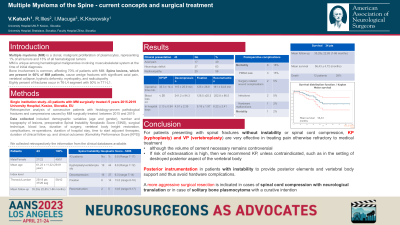Multiple Myeloma of the Spine-current concepts in surgical treatment
Multiple Myeloma of the Spine-current Concepts in Surgical Treatment
Friday, April 21, 2023


Vladimir Katuch, MD, PhD
Chairman
Dept.of Neurosurgery, University Hospital, Kosice, Slovakia
Kosice, Slovakia
ePoster Presenter(s)
Introduction: Multiple myeloma (MM) is a clonal, malignant proliferation of plasmocytes, representing 1% of all tumors and 13% of all hematological tumors. Spine lesions cause wedge fractures with significant axial pain, vertebral collapse, kyphotic deformity, myelopathy, and radiculopathy. The present study aims to determine current concepts in the surgical treatment of multiple myeloma of the spine.
Methods: Between 2015 and 2019, the findings of 43 multiple myelomas of the spine patients were analyzed in a prospective trial at the Department of Neurosurgery, University Hospital in Košice, Slovakia. The incidence of postoperative complications was analyzed, and the risk factors were investigated. The overall mean survival time was identified.
Results: The present study's overall mortality and morbidity rates were one patient (2%) and eight patients (18%). The mean follow-up and survival time were 35,29± 22,85 and 56,43 ± 4,72 (months). Twelve patients (28%) died during follow-up. The present study includes 21male and 22 females, mean of age 61,23 ± 11,32. The radiologic findings confirmed multiple-level involvement 21 (49%), paravertebral mass 18 (42%), and epidural spinal cord compression 27 (63%). Surgical procedures included kyphoplasty/vertebroplasty 19 (44%), decompression 16 (37%), fixation 6 (14%) and reconstruction surgery 2 (5%).
Conclusion : For patients with spinal fractures without instability or spinal cord compression, kyphoplasty and vertebroplasty are very effective in treating pain; otherwise refractory to medical treatment. However, the volume of cement necessary remains controversial. Posterior instrumentation should be indicated in patients with instability to provide posterior elements and vertebral body support and thus avoid hardware complications. A more aggressive surgical resection is indicated in cases of spinal cord compression with neurological translation.
Methods: Between 2015 and 2019, the findings of 43 multiple myelomas of the spine patients were analyzed in a prospective trial at the Department of Neurosurgery, University Hospital in Košice, Slovakia. The incidence of postoperative complications was analyzed, and the risk factors were investigated. The overall mean survival time was identified.
Results: The present study's overall mortality and morbidity rates were one patient (2%) and eight patients (18%). The mean follow-up and survival time were 35,29± 22,85 and 56,43 ± 4,72 (months). Twelve patients (28%) died during follow-up. The present study includes 21male and 22 females, mean of age 61,23 ± 11,32. The radiologic findings confirmed multiple-level involvement 21 (49%), paravertebral mass 18 (42%), and epidural spinal cord compression 27 (63%). Surgical procedures included kyphoplasty/vertebroplasty 19 (44%), decompression 16 (37%), fixation 6 (14%) and reconstruction surgery 2 (5%).
Conclusion : For patients with spinal fractures without instability or spinal cord compression, kyphoplasty and vertebroplasty are very effective in treating pain; otherwise refractory to medical treatment. However, the volume of cement necessary remains controversial. Posterior instrumentation should be indicated in patients with instability to provide posterior elements and vertebral body support and thus avoid hardware complications. A more aggressive surgical resection is indicated in cases of spinal cord compression with neurological translation.
